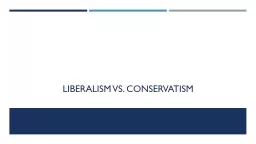

Definitions Liberalism Ideas of social progress economic development and the upper middle class Society governed by a constitution that valued individual rights Economic Liberalism Often associated with Liberalism Supported laissezfaire ID: 612401
Download Presentation The PPT/PDF document "Liberalism vs. Conservatism" is the property of its rightful owner. Permission is granted to download and print the materials on this web site for personal, non-commercial use only, and to display it on your personal computer provided you do not modify the materials and that you retain all copyright notices contained in the materials. By downloading content from our website, you accept the terms of this agreement.
Slide1
Liberalism vs. ConservatismSlide2
Definitions:
Liberalism:
Ideas of social progress, economic development, and the
upper middle
class. Society governed by a constitution that valued individual rights.
Economic Liberalism:
Often associated with Liberalism. Supported laissez-faire
economics (Adam Smith)Slide3
Definitions:
Conservatism:
Justified the status quo, defend tradition and hierarchy, and stress limitations of human understanding.
Edmund
Burke
–
Society
exists through a continuity of traditionsSlide4
Spread of Liberalism:
As populations grew, and conditions within cities continued to degrade, citizens began to look to
charity
and
government
for help
Great Britain (Best Example):
Reform Bill (1832)
– Extended the franchise to the Middle
Class and redistricted to reflect population shifts into the cities
Repeal
of the
Corn Law(1846
)
– Protective tariff on foreign wheat (1815)Slide5
Chartist Movement (1838- 1850):
Universal male suffrage
Equal-sized electoral districts
Voting by secret ballot
No property qualifications
Pay for members of Parliament
Annual elections of Parliament
Working class activists who supported the People’s Charter (The Six Points of Chartism)
House of Commons refused to acknowledge the charter – demonstrations (1848)
Results –
Short term – Failure
Long-term – all but annual elections took effectSlide6
Common Problems for Liberalism:
Despite the fact that Liberalism would survive, it still went through a variety of domestic problems:
Suffrage – Debate over women’s suffrage
State – Role in matters of social welfare and the economy
Size – Growth of bureaucracies and local governments increased social and class conflict
National Identities – Should certain groups be included within the Nation
? (Irish Home Rule – Liberal split)Slide7
Forms of Attack on Liberalism:
Radicalism – Marxism, Trade Unions, and Anarchism (
Labour
Party)
Conservatism – Attacked the shallowness of middle class culture and capitalism
The Church – Attacked the materialness and selfishness of modern society. Continuation of conflict between Church and State
Philosophy – Belief that humanity was irrational, ruled by intuition rather than reasonSlide8Slide9